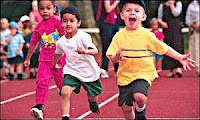 Children who do not take enough exercise are in danger of suffering broken bones in later life, according to a study.
Children who do not take enough exercise are in danger of suffering broken bones in later life, according to a study.
Many are failing to build up their skeleton during a vital two-year window before puberty, which is critical to building healthy bones.
Researchers in Canada have found children have the greatest increase in bone mineral after the growth spurt just before puberty.
In girls this tends to be between 10 and 12 and in boys it is from 13 to 15.
Extra effort to exercise during this time can make a big difference, say researchers at the University of British Columbia in Vancouver, who are studying 383 children.
Research co-ordinator Heather McKay said: "If we can increase bone mass by 10% by adulthood, we can decrease the incidence of fractures by 50%."
The young volunteers took part in a circuit training programme lasting 10 minutes just three times a week.
Children in this group have to skip and do box jumps, side-to-side jumps and other high-impact exercises.
Other children spend the same amount of time doing stretches and warm ups.
After a year, the girls doing circuit training had amassed an extra 2% of bone mineral compared with the stretchers.
After two years they were ahead by 5%, it is reported in New Scientist.
'Banking' bones
The results on boys are still being analysed.
People lose a quarter of their bone mass as they age.
Whether this weakens our bones largely depends on how much we build them up in childhood.
Experts believe changes need to be made to the way physical education is taught in schools.
The National Osteoporosis Society (NOS) believes these findings need to be taken on board by parents and children.
A spokesman said: "The NOS is concerned about the type of physical activity that children are getting, often with too little emphasis being put into weight bearing exercises such as running, skipping and jumping.
"The NOS would like every child to get the right level of physical activity and put "bone in the bank" for later in life.
"Many children need to be more physically active and one of the ways of tackling the huge problem of osteoporosis is to encourage youngsters to increase peak bone mass by taking enough of the right type of exercise with a well-balanced calcium rich diet."
Source: http://news.bbc.co.uk/1/hi/health/1751664.stm
Tuesday, July 24, 2007
Lazy children risk broken bones
Posted by
Catherine McDiarmid-Watt
at
10:02 AM
![]()
Labels: broken bone, children, exercise
Subscribe to:
Post Comments (Atom)




No comments:
Post a Comment